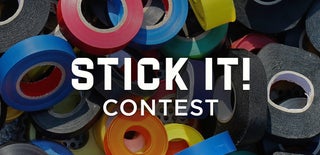Introduction: Popcorn Ceiling Removal Tool
**WARNING** If you are unsure of the age of the house, you should have the popcorn ceiling tested for Asbestos before engaging in this sort of project. Anything older than the 1990's is liable to contain asbestos and painted popcorn has been a way for owners to "seal in" the asbestos. You the user, are liable for your own safety and should do your homework before removing a popcorn ceiling.
After removing popcorn ceiling several times and wanting to minimize the mess, I did some looking around on the internet for some alternatives. If you've ever done this before, you know the mess you will create on the floor that you will then track around if you just scrap it off. I found several videos of people using these types of tools they created and wanted to share how we built ours and what we learned.
Required Items(BOM):
1. ($5) Duct Tape
3. ($8-$9)10-12" Drywall Taping Knife
4. ShopVac
5. ($12)12-14" x 2-1/2" Nozzle ShopVac
6. ($8)Extension Tube/Wand for ShopVac approx. 20" (1 is required, 2 can be helpful)
7. ($11)ShopVac Filter (This process will pretty much consume 1 filter.)
8. Ladder
Total cost: $45 (And worth every penny)
Time to build: 20 minutes or less.
Usefulness: Very (Once a room is prepped I can knock it out with this in no time.)
Rating: 4.7 Stars
Note:There are a couple of products out there, which will directly catch what you scrap off into either a bucket or a bag attached to the scrapper. The problem with these tools is the amount of weight you end up carrying in either one hand or the other due to the popcorn and the water applied to the popcorn. With water weighing 8.3lbs per gallon you can easily add a lot of weight to the popcorn during removal.
Why I chose this option: In this house we wanted to save the carpet, remove the popcorn, apply knockdown to the ceiling and then paint the walls in as little time as possible. Thus I didn't want to pickup the plastic we laid over the carpet to remove the popcorn, to then turn around and lay down plastic again to apply knockdown and paint. This allowed us to lay down plastic once, saving us time and money.
Step 1: Building the Tool
1. Attach the extension wand/tube to the nozzle by pressing them together.
2. I taped a wood spacer to this assembly, so that I could adjust the angle of the knife.
3. Tape the knife handle to the entire assembly. Preferably with the knife edge in approximately the center of the nozzle opening in both directions. Start with a single piece of tape so you can adjust location and angle of the knife relative to the nozzle.
4.Then tape the blade down as close to the nozzle as possible. This keeps the knife from trying to twist or move side to side. Do notmake the tape to tight as you will bow the blade, which will cause problems.
Step 2: Using the Tool
Now that the tool is built, all you need to do is wet the popcorn, attach the tool to the Shopvac, turn on the Shopvac and start scraping. If you have a second extension wand/tube for the Shopvac you can use the tool from the floor on 8' ceilings. After some use you will figure out the right amount of force and angle that works best for you.
Usage notes:
1. This isn't a perfect tool, but it keeps a majority of the popcorn off the floor and into the Shopvac.
2. The corners of the nozzle don't always vacuum out, so occasionally tilting the nozzle side to side clears out the corners.
3. After every room I would turn the Shopvac off and clean off the filter with my hand as best I could. Keeping the filter clean and the Shopvac empty as best you can will be beneficial.
4.. Depending on the width of the knife and nozzle you use, you will find that you can't reach the edges and corners. To get around this I used another knife to clear the edges and another nozzle to try to catch what I was taking off.
5.You may want to file down the corners of the knife to avoid gouging the sheet rock unintentionally. I didn't, but I probably will next time.
Enjoy!

Participated in the
Stick It! Contest











